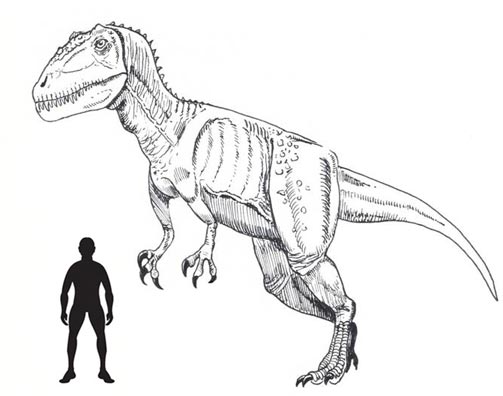New species of Carcharodontosaurus Discovered in Niger
For graduate Steve Brusatte, a palaeobiologist at the University of Bristol, England, the long wait for the naming and describing of his 1997 fossil find is finally over. Elements of the skull, including the premaxilla and cervical vertebrae discovered in an expedition to Niger (Africa) have been described in the scientific publication “The Journal of Vertebrate Paleontology” out this week.
New Carcharodontosaurus Species
Although only fragments of the skeleton have been found the skull material and teeth have enabled scientists to identify this animal as belonging to the Carcharodontosaurus genus. The animal has been named C. iguidensis and it would have been one of the top predators in the area around 95 million years ago (Cenomanian faunal stage).
The carcharodontosaurids are named after the Great White Shark (C. carcharias), these fierce meat-eaters (the name means shark toothed lizards), roamed North Africa in the Cretaceous and one species C. saharicus is estimated to have rivalled Tyrannosaurus rex and Giganotosaurus as being the biggest theropod discovered so far. The carcharodontosaurids are members of the allosaur family. Size estimates for this new species put this animal at around 14 metres in length, but considerably lighter than the likes of T. rex, Giganotosaurus and its close relative from Morocco C. saharicus. It weighed approximately 3.2 tonnes.
A Scale Drawing of a Carcharodontosaurus
There were a number of large theropods roaming this part of the Gondwanaland during this stage of the Cretaceous, as well as the carcharodontosaurids, there were the likes of the spinosaurids and the abelisaurs. However, it seems likely that these massive carnivores did not necessarily compete with each other over food sources. Studies of jaw material indicates that the spinosaurs may have been mainly fish eaters, whilst the abelisaurs had much more slender and narrow jaws perhaps indicating a different prey than the broader and sturdier jawed carcharodontosaurids.
PNSO have developed a large range of theropod replicas including Carcharodontosaurus: PNSO Dinosaur Models and Figures.
The carcharodontosaurid family are still not well known, the original fossils were described by the famous German palaeontologist Ernst Stromer von Reichenbach. Several expeditions were sent to North Africa between 1911 and 1914. At first the fossils of carcharodontosaurids were classified as belonging to a megalosaur, the Megalosaurus genus has been used as a dumping ground for unknown theropod remains for many years. The original fossil bones and teeth were destroyed by bombing in WWII, only later did these fossils get ascribed to their own separate genus. Megalosaurs have been used to place various indeterminate fossils of meat-eaters, a previous web log article discussed this point:
Megalosaur Miscellany
Commenting on the abundance of large meat eaters in North Africa at this particular stage of the Cretaceous, Steve Brusatte stated that during this period sea levels were rising and this may have isolated dinosaur communities, allowing new species of carnivorous dinosaur to evolve.







Leave A Comment